The recent steel-cutting ceremony for HMS Formidable, the third Type 31 frigate, is especially significant as the programme to build 13 frigates on Scotland is now over halfway.
With this latest development, there are currently seven Royal Navy ships under construction in Scotland.
This includes three Type 31 frigates: HMS Venturer, HMS Active, and HMS Formidable, as well as four Type 26 frigates: HMS Glasgow, HMS Cardiff, HMS Belfast, and HMS Birmingham.
These ships, built in Scotland, are supporting thousands of jobs and will be a critical part of how the Royal Navy keeps our country safe.
2/2 pic.twitter.com/bX6Xm2msOr
— Scotland Office (@ScotSecofState) October 8, 2024
The Type 31 frigate, also known as the Inspiration-class, is a class of general-purpose warships being built for the Royal Navy. Developed under the Royal Navy’s “National Shipbuilding Strategy,” the Type 31 aims to provide a versatile and cost-effective platform, complementing the more advanced Type 26 frigates. Each vessel in the class is designed to displace around 5,700 tonnes, with a length of approximately 138 metres. The design focuses on modularity, allowing for adaptability in various roles, including maritime security, disaster relief, and low-intensity operations, alongside its core warfighting capabilities. With a focus on export potential, the Type 31 is intended to be an attractive option for allied navies seeking a capable yet affordable frigate.
In terms of capabilities, the Type 31 frigate is equipped with a range of sensors and weapon systems suitable for multi-role operations. It features a 57 mm Mk 110 naval gun as its primary armament, complemented by 40 mm cannons for close-range defence. The frigate is also fitted with the Sea Ceptor surface-to-air missile system, providing area defence against airborne threats. Additionally, it is capable of deploying a range of smaller boats and unmanned vehicles from a spacious mission bay, enabling flexibility in tasks like boarding operations or mine countermeasures. The Type 31’s flight deck can accommodate a medium-sized helicopter, such as the Wildcat or Merlin, further enhancing its reach and capabilities for anti-submarine warfare, search and rescue, and reconnaissance missions.
The Type 26 frigate, also known as the City-class, is a class of advanced anti-submarine warfare (ASW) vessels being built for the Royal Navy. Designed as part of the Royal Navy’s modernisation efforts, the Type 26 is intended to replace the ageing Type 23 frigates, particularly in the ASW role. Each ship in this class has a displacement of around 8,000 tonnes and measures approximately 149.9 metres in length. The Type 26 is characterised by its focus on stealth, featuring a hull design and noise-dampening measures to minimise acoustic signatures, making it highly effective in detecting and countering submarines. The first four vessels, HMS Glasgow, HMS Cardiff, HMS Belfast, and HMS Birmingham, are currently under construction, with with the work on the rest of the order at various stages of procurement.
In terms of capabilities, the Type 26 frigate is equipped with an array of advanced sensors and weapons. It is armed with a 5-inch Mk 45 naval gun, providing long-range fire support, and is equipped with the Sea Ceptor missile system for area air defence. For ASW, the frigate carries powerful sonar systems, including a towed array, and can deploy anti-submarine torpedoes. The Type 26’s mission bay is designed to support a range of operations, from humanitarian aid to counter-piracy, allowing for the deployment of unmanned systems and small boats. Additionally, the flight deck is capable of supporting a range of helicopters, including the Merlin, which enhances its ASW and reconnaissance capabilities. With its combination of advanced systems and modular design, the Type 26 is intended to be a versatile platform that can adapt to a variety of operational demands.
At the UK Defence Journal, we aim to deliver accurate and timely news on defence matters. We rely on the support of readers like you to maintain our independence and high-quality journalism. Please consider making a one-off donation to help us continue our work. Click here to donate. Thank you for your support!



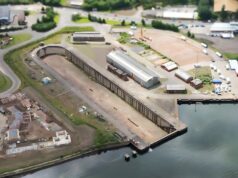
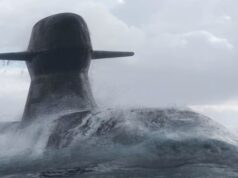


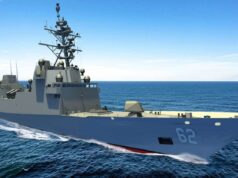
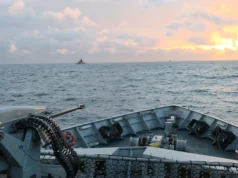

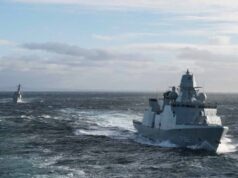
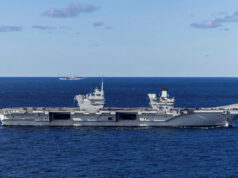
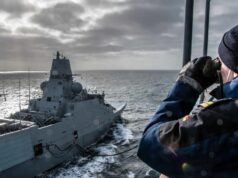

Great see, although this level of shipbuilding really should be the baseline for any navy that wants to remain a significant blue water player.
Parallel and continuous drumbeats of escorts, auxiliaries and submarines to keep skills sharp, costs low and the fleet effective/young.
We could easily have this between Barrow, Rosyth, Govan and CL/A&P taking up any slack fabricating sections in between its repair work.
I agree, two mid sized yards working in surface ships at a steady clip of one every two years should be an absolute minimum with several other yards providing pre fabrication work.
It’s essential that we have hot production lines as it’s the best way to achieve exports.
That being said with the continued limping on of H&W the likely cancelation of T32 and very distant commitment to just 3 MRSS it’s likely that Rosyth will close and H&W will close once the FSSS are built or before if Navantia don’t bail them out.
The last government talked a good game on ship building but was never willing to actually put any money forward.
Moving to three surface yards when there is not a big enough fleet to sustain two was a disaster.
need to go to continuous build for both. 1 a year, when you get to year 15 decide to keep (expand fleet) and refit to the latest standard on ship 15, or sell as is, or sell upgraded, keep but mothball, keep upgrade and mothball.
This just about eliminates obsolescence, this will save around the cost of a couple of t26’s, and no i’m not kidding. all the reviews/committee’s/testing and years of time to replace obsolete parts are exceedingly expensive, and that’s of course when you actually have the funding to do all of it (they don’t and never will)
This was the plan with T23, look how well that went
CL is fabricating sections for dreadnought, type 26 and building a ferry.
I don’t think it is all well and sunny at CL.
There are elements that are well beyond their capabilities.
Modules is more accurate for Dreadnaught and blocks/units for Type 26. Oh, and the Mersey Ferry has already started. There’s an article about Cammell Laird ramping up production for 2027 by Inside Media.
HI SB,
There is also an article on Navy Lookout that is quite up beat about CL suggesting that they have got through their difficulties. Certainly they had tough times trying to get restarted after they where closed down – H&W seem to be following a similar path…
Cheers CR
Can we “have some more please Sir Keir” Asks the Naval clerk Charles Dickens from his Chatham Dockyard office.
We need a Bigger Navy!!!
A minor point but saying approximately 149.9m is a bit silly, quoting a figure to 4 significant figures is extremely accurate. An approximate length would be 150m.
The digital plans might well be 149.9 meters but the actual vessel might be more or less depending on construction tolerances and temperature.
There is a far greater mathematical error in the article where it says the program is more than half way. Given that the first vessel isn’t finished and the seventh has just started having steel cut I would estimate that the program hasn’t yet reached the 25% stage of construction or less than a quarter.
I thought that, just shows how you display things statistically doesn’t necessarily remotely accurately reflects the reality. If conflict started now there would be a 0% contribution by these ships.
The hard bit is the fit-out and getting everything g to work.
Building hulls is relatively straightforward…..
exactly what i thought!
The Government should order another batch of 5 Type 31s (or as #2s) and reap greater economies of scale before production winds down on Batch 1. It would hard to argue against another batch of 5 Type 26s too and I would add HMG should go the opposite direction to what they have down with naval construction in the last 20yrs and speed up construction, the US spit out an Arleigh Burke in ~4yrs!
I would expect export opportunities would materialise too and once a proper build drum beat has been established, the RN can start to get the critical mass it needs to defend, fight and win in the future.
I’d like to see a rolling contract for second tier escorts, delivered every 15 months from Rosyth, initially based on the Arrowhead 140 at maybe £400m a unit (£320m a year rising with GDP), with a fit out agreed by the Navy to sit within that cap and regular design upgrades by Babcock for efficiency.
If Babcock doesn’t screw up and provides value for money, they’d just keep churning them out and second-hand ones would be sold off maybe 15 years after launch. I think that would give the Navy around 10 high-availability ships to complement the top-tier escorts. By adjusting exactly when they are sold, the Navy could operate more or fewer as required.
We currently spend about £2.1bn a year on surface ship procurement, so £320m a year is
affordable. Unfortunately, without government commitment to crew, operate and maintain the available ships, it wouldn’t work.
We have MCM motherships, MRSS and SSNs in the build pipeline next, there is going to be no money for frigates.
We have plenty enough budget available if we plan ahead, don’t go overboard on the T83 spec and don’t allow the SSN(A)s to leech money from the surface ship budget. MRSS and Motherships needn’t be too pricey. Portugal’s multi-role flat top from Damen is only costing OPV money. of course, the RN will want something bigger and more fighty, but it needs to be restrained from unnecessary ovespend on support ships. The Treasury probably pissed away half a billion on FSSS, but let’s hope they learned their lesson.
Asking MOD to actually follow plans is like pissing in the wind. There always seems to be political reasons why the best laid plans gang agley.
That Portuguese ship isn’t good for anything. It costs OPV money because it has barely any military equipment
I would agree , I am certain if uk banged out t26 and t31 at a faster rate and ordered another 6 batch of each basic shells as an example without even budgeting for weaponry. These shells would either be purchased by Royal Navy in the future or snapped up by a foreign nation for a fast modernisation of their own fleet. Another opportunity missed for British industry with maintenence contracts .
Certainly our competitors have won export success by having this sort of capacity to quickly adjust to market needs. Hopefully we belatedly match them and fight for sales on an even keel (sorry)
I dont see how we can compete with the likes of Naval group or Italy, theyre far more efficient and cost effective.
“… I am certain if uk banged out t26…”
Too expensive to keep banging out, if the RN only requires a certain number.
These vessels have classified aspects to them.
“The Government should order another batch of 5 Type 31s…”
Why do you want to order more T31 frigates, without the new type frigate having been tested yet?
If on the books, the first Type 31s will reach IOC as the construction hall is ready for any Batch 2 construction. Lessons-learnt may be applied and improvements made on this second batch, which may be, used as the basis for the muted Type 32s.
Just like an earlier comment, with batch order after batch order, RN critical mass can grow, with newer units replacing older units earlier, allowing these older units to either fill a reserve fleet or be offloaded to allied nations, with the end user bearing refit costs of course!
This is where you run into SNP accounting
Seven RN ships in build = two ferries*
*that may or may not ever work properly.
Joking apart I suspect the real reason for the SNP absence at ship launches is ferry related. Quite embarrassing for ferries to be overtaken by warship build programs.
Shines a light on how difficult shipyard management actually is and why Boaty Mc Boatface had to be finished off abroad.
Didn’t the SNP years back claim that the military work would be eventually replaced by civil ship building. That optimism seems long gone.
Have they decided to put onboard ASW torps on it after all?
From the embarked ASW Helicopter.
Yes they are keeping thousands of people in employment. Mainly romainian polish south african phillipino nations something the british goverment dont like to tell you british ships for british yards built by foreginers ge it right
The people who apply for the well paid jobs?
You can only hire people who apply and turn up for work.
The British ‘worker’ expects a four hour working day (not joking) for more money than they were on pre COVID.
Hopefully will mirror the smallest of small 🦂. 👍 Size is important for aircraft to get airborne. But for defense, small is surely the way. Especially with our fantastic lazer tech.
Just need seven more asap
Seven more? We wish
Can’t understand other than keeping the scottish voter’s happy Why they’ve put all navy new builds in Scotland rather than sharing the work around l,as in sir John parkers shipbuilding strategy. Yards down south have been sold down the river by successive governments.
Would you want a navy ship built by the Northern Irish after the last time they built a ship? 🫣🤣
might be building 7 but none will be ‘at sea and operational’ for at least 3 years
Surprised at the Scottish lack of interest, in the countries employment and one of the few industries it has. Why not give the contracts to an England based shipyard, the employment would be appreciated and the ministers appreciate it by attending any significant ceremonies.